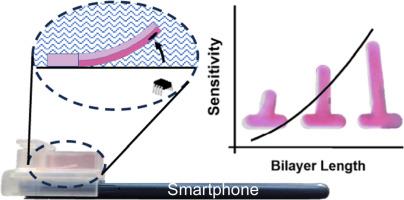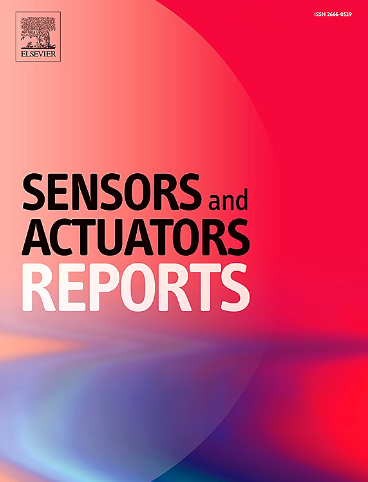智能水凝胶具有数量级提高灵敏度的智能手机指南针为基础的化学传感
IF 7.6
Q1 BIOTECHNOLOGY & APPLIED MICROBIOLOGY
引用次数: 0
摘要
基于智能手机的平台有潜力提供低成本和可访问的测量工具。最近,一项首次概念验证研究引入了基于磁力计的智能手机诊断技术,该技术使用手机罗盘进行信号转导,作为现有众多使用手机摄像头的光学诊断技术的补充。通过使用运动放大双层水凝胶致动器将化学浓度转化为磁场强度的变化,这种基于磁力计的新型智能手机诊断技术实现了低成本的高灵敏度,但其最终灵敏度从未被探索过。在这里,我们进一步提高了这种平台的灵敏度,实验证明了双层长度和灵敏度之间的二次依赖关系,在概念验证中至少产生一个数量级的增益,以达到40µpH的估计灵敏度。该技术已在pH水凝胶致动器上进行了演示,但由于它只需要改变致动器的几何形状,因此无论目标分析物如何,它都可以普遍应用。还提出了传感器响应的完整解析模型,提出了提高灵敏度和控制传感器动态和线性范围的其他前景。这种灵敏度的提高扩大了在人类健康和环境监测方面的潜在应用。本文章由计算机程序翻译,如有差异,请以英文原文为准。

Smart hydrogels with order-of-magnitude enhanced sensitivity for smartphone compass-based chemical sensing
Smartphone-based platforms have the potential to provide low-cost and accessible measurement tools. A first proof-of-concept study recently introduced magnetometer-based smartphone diagnostics, which use the phone compass for signal transduction, as a complement to the numerous existing optical options, which use the phone camera. With the use of motion-amplifying bilayer hydrogel actuators to translate chemical concentrations into changes in magnetic field strengths, this new form of magnetometer-based smartphone diagnostic achieved promising sensitivity with low cost, but its ultimate sensitivity was never explored. Here, we further enhance the sensitivity of such platforms, experimentally demonstrating a quadratic dependence between bilayer length and sensitivity that yields at least an order-of-magnitude gain over the proof-of-concept to reach an estimated sensitivity of 40 µpH. The technique is demonstrated on pH hydrogel actuators, but since it requires changing only the geometry of the actuator, it can be applied universally, regardless of the target analyte. A full analytical model of sensor response is also presented, suggesting additional prospects for increasing sensitivity and control over sensor dynamic and linear ranges. Such enhancements in sensitivity expand potential applications in human health and environmental monitoring.
求助全文
通过发布文献求助,成功后即可免费获取论文全文。
去求助
来源期刊

Sensors and Actuators Reports
Multiple-
CiteScore
9.60
自引率
0.00%
发文量
60
审稿时长
49 days
期刊介绍:
Sensors and Actuators Reports is a peer-reviewed open access journal launched out from the Sensors and Actuators journal family. Sensors and Actuators Reports is dedicated to publishing new and original works in the field of all type of sensors and actuators, including bio-, chemical-, physical-, and nano- sensors and actuators, which demonstrates significant progress beyond the current state of the art. The journal regularly publishes original research papers, reviews, and short communications.
For research papers and short communications, the journal aims to publish the new and original work supported by experimental results and as such purely theoretical works are not accepted.
 求助内容:
求助内容: 应助结果提醒方式:
应助结果提醒方式:


